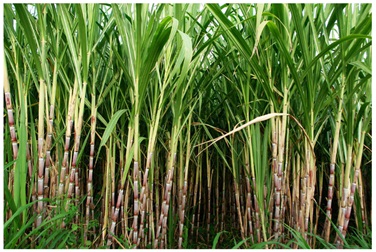DEFINITION OF SOME TERMS USED IN SUGAR FACTORY
- Sugar cane (Saccharum officinarum) : Primarily cultivated for its juice from which sugar is processed. Most of the world’s sugarcane is grown in subtropical and tropical areas. A hot , moist climate with dry a dry ripening season is suitable for its growth, while a very low temperature or suddenly lowering temperatures may affected it adversely. The plant is also grown for biofuel
- Chlorophyll : Green colouring pigment present in the leaves of plants.
- Photosynthesis : Process by which energy of sunlight is used by plants for converting C02 from atmosphere and H2O into sugars.
CO2 + H2O Sunlight & Chlorophyll C6H12O6 + O2
- Cane Maturity : State of full development, ready for harvesting and use.
- Bagasse : Residue of sugarcane after extracting juice from it through milling.
- Cane preparation : Process of cutting sugarcane to fine pieces without breakage of its cell.
- Fibre : Thread like slender parts of sugar cane, insoluble in water or juice.
- Clarification : Treatment of cane juice after milling for removal of suspended, colloidal and dissolved impurities.
- Clarifier : A closed equipment for settling of treated cane juice, for decantation of clear juice and removal of settled portion, termed as muddy juice.
- Filter cake : The insoluble material from treated juice retained on screen or cloth of filter.
- Bagacillo : Fine fraction of bagasse obtained by screening of bagasses, generally used as a filter aid in filtration.
- Clarified or Clear juice : The juice obtained from clarifier after separation of precipitated impurities.
- DEVC : Double Effect Vapour Cell which containing only two bodies in series.
- Multiple effect : A set of bodies in which cane juice is concentrated through evaporation with maximum use of vapours generated by boiling of juice.
- Semikestner : A boiling vessel in which juice is boiled under pressure by exhaust steam in sugar factory as a1st effects body for clear juice concentration. It is a rising film evaporator with tube length 4 to 5 mtr.
- Vapour cell : A boiling vessel in which juice is boiled under pressure, the pre-evaporator vapour thus generated being used for heating or boiling in process of manufacture, while the concentrated juice is led to multiple effect evaporator. It is a rising film evaporator with tube length 2 to 2.5 mtr.
- Robert Body : A boiling vessel in which juice is boiled under pressure or vacuum with pre-evaporator vapour being used for heating or boiling in process of concentration of juice into syrup. It is a rising film evaporator with tube length 2 mtr.
- FFE ( Falling Film Evaporator ) : A boiling vessel in which juice is boiled under pressure or vacuum with exhaust steam or pre-evaporator vapour. Juice circulated by pumps from top side with proper arrangements of juice distribution. Its tube length is between 10 to 12 mtr.
- Exhaust steam : Steam from prime mover after generation of power.
- Live steam : Steam from boilers either at the boiler pressure employed for power generation or at reduced pressure for use in process.
- Syrup : Concentrated clear juice from evaporator.
- Brix : Dissolved solids in sugar bearing liquid. The per cent by weight of solid matter as indicated by the brix spindle or calculated from densimetric measurement converted to the brix scale.
- Condensate : Hot water obtained on condensation of vapour or steam used for heating or boiling.
- Calandria : Part of a boiling vessel fitted with tubes or coils in which juices or syrups or thick liquors are heated by steam or vapour.
- Scale : Deposit mostly consisting of inorganic salts on the inside of tubes in boilers or heating and evaporator vessels or pans. Coating of thin film of material outside the tubes of juice heaters, evaporator vessels or pans.
- Vacuum : State of reduced atmospheric pressure in a vessel.
- Condenser : Apparatus in which vapours are condensed by cooling with water.
- Seed : Mass of fine sugar suspended in syrupy liquid boiled in vacuum pans with sugar bearing liquids.
- Massecuite : Mass of sugar crystals surrounded by sugar containing liquor, obtained in vacuum pans.
- Molasses : Mother liquor separated from sugar crystals contained in massecuite.
- Heavy Molasses : Mother liquor obtained by centrifugal separation of sugar crystals from massecuite with little or no use of water.
- Light molasses : Mother liquor obtained during centrifugal operation with application of water, after separation of heavy molasses from massecuite.
- Pan : Apparatus in which syrup or molasses are boiled so as to obtain sugar crystals of the desired size.
- Molasses conditioner : Dilution of molasses from different massecuite to about 70° conditioning Bx followed by heating to 70°C to avoid dissolved air.
- Final molasses : Mother liquor obtained from the last stage of boiling from which sugar can no longer be recovered economically in the process of Sugar manufacture.
- Crystalliser : Apparatus in which the massecuite from pan is discharged, equipped with stirring mechanism.
- Centrifugal : Machine for separation of sugar crystals from mother liquor by rotary motion and centrifugal force.
- Superheated water : Water heated under pressure above its boiling point.
- Spinning : Separation of Sugar crystals in centrifugal machines
- Pug mill : Vessel, provided with stirrer, on top of centrifugal machines receiving massecuite or magma, which feeds the centrifugal machine.
- Grass hopper : Sugar conveyor with shaking motion.
- Grader : Apparatus with set of screens subjected to vibrations for classifying final sugar into different size grains.


